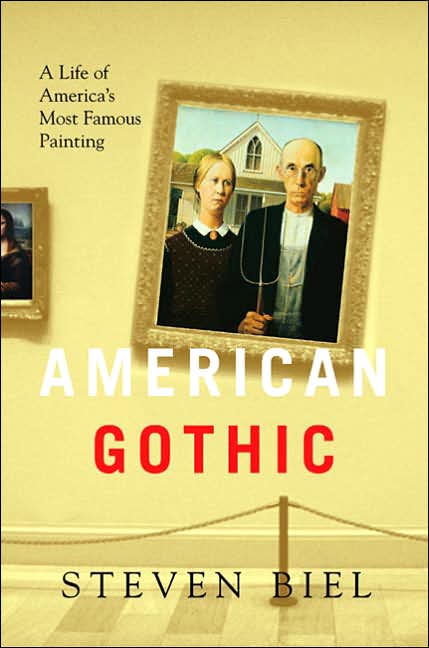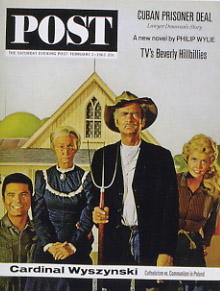by Ronald Sklar
Copyright ©2005
PopEntertainment.com.
All rights reserved.
If
imitation is the sincerest form of flattery, then Grant Wood must be
flattered out the wazoo. Although the artist of “American Gothic” died in
1942, his painting has gone on to symbolize all things American, and
parodied by Madison Avenue, Hollywood, and both the left and right-wing
press.
This odd depiction of our culture has inspired, flabbergasted, outraged
and obsessed generations of Americans. However, everybody instantly
recognizes it and somehow “gets” it.
Arguably the most famous painting in our country’s history (“Whistler’s
Mother” is a distant second), the work was almost rejected and forgotten
when it was first presented in 1930. It has since developed a legendary
story about the ultimate in recycling.
This fascinating chapter in American history has been captured by Harvard
historian Steven Biel in his new book, American Gothic: A Life
of America’s Most Famous Painting (W.W. Norton and Company). Here, he
takes a few moments to reveal the painting’s importance.
What inspired you to
write this book?
I’m
interested in objects and events that have become overly familiar. I wrote
a book about the Titanic disaster a few years ago (Down with the Old
Canoe). This was before the [1997] movie came out, before it saturated
popular culture more than ever. I’m interested in things that have been
flattened out to clichés and I try to recover the history behind them and
find out why they’re famous. In this case, [the painting’s fame] is all
out of proportion to its humble origins and to its artistic merit compared
to other "masterpieces.”
What is the story
behind the painting?
Grant Wood was an unknown artist from Cedar Rapids,
Iowa in 1930. He went down to a small town in south-central Iowa
called Eldon. He traveled there because a friend of his was running a
community fine-arts project. He was riding around in a car with another
artist named John Sharp. While riding, they encountered this house on the
outskirts of Eldon – an extremely modest clapboard house, but it had this
gothic window, which stood out. It was not completely
unexceptional in the Midwest, but it was strange enough to get Wood to get
out of the car.

He
decided to put some figures in the foreground that could possibly belong
to this strange house. He had his sister and his dentist pose for it. He
distorted them – he elongated them with grim expressions. Then he entered
it into a contest at the Art Institute of Chicago, where it received third
prize. A notable critic reprinted it in newspapers, and from there, it
took off.
Originally, it took off because it was ridiculing the Midwest and the
kinds of people who supposedly lived there
– uptight, repressed, puritanical and generally
nasty. The sort of yokels that writers like H.L. Mencken would poke fun at
throughout the 1920s. It also stirred up a controversy in Iowa because the
farmers really thought it was an insult to them. Its initial fame was born
out of controversy, out of the perception that its meaning was satirical.
Describe the painting
strictly from an artistic and aesthetic viewpoint.
It’s a realistic portrait of a man and a woman posed in front of a house.
The woman is wearing a rickrack apron. The man is wearing overalls, a dark
coat and a collarless shirt. He’s holding a hayfork, which directly
mirrors the gothic window. The pattern of the hayfork is repeated in the
pattern of the man’s overalls if you look closely. There is a
clear
blue sky in the background, highly stylized, rounded trees, a red barn
off on the right side, a snake plant on the porch on the left that mirrors
a lock of hair running down the woman’s neck. The man is directly looking
at the viewer. The woman is looking off to the side.
Some have said that what lends itself to parody formally
is that you have these two figures facing us
and it’s easy to plug other faces into them
and to substitute something else in place of the pitchfork.
In the beginning, the painting was despised by certain people and
celebrated by others. As time went on, the painting took on new meanings.
It
was despised and embraced, as far as I can tell, for the same reasons. It
was perceived as being a work of satire. The critics who really made
Wood’s reputation understood it that way. They understood him as a victim
of these people and their repressiveness and hostility.
Initially, the people who despised it were Iowa farmwives who wrote
letters to newspapers protesting being depicted as primitive idiots.
How exactly did this painting become an American icon, the most famous
painting in American history?
There is no quantifying that, really, but I would say so. It happened
because over the course of the thirties in the context of the depression
and throughout World War II, it changed from being that satirical image to
a national symbol of stability, order, prosperity, virtue and
wholesomeness.
Instead of holding its subjects up to ridicule, it now came to be seen as
holding them up for admiration as quintessential Americans. In hard
times, the “let’s make fun of yokels” idea seemed kind of cruel. The
conservative virtues of the Midwest were re-embraced by some East Coast
critics, and even the left in the 1930s paid homage to the fortitude of
the “folk.” It was a way of fighting off despair.
Some people say that the subjects are husband and wife; others say they
are father and daughter. Which is it?
Wood was non-committal on this. His sister, Nan, probably because she was thirty-something when she posed
[and Dr. McKeeby was in his sixties], was really offended by the idea that
they might be husband and wife. It was she who really took the lead in
insisting that they w ere meant to be father and daughter. Wood, as far as we
know, left no record of his intentions. We don’t have anything that tells
us what he was thinking when he painted this.
ere meant to be father and daughter. Wood, as far as we
know, left no record of his intentions. We don’t have anything that tells
us what he was thinking when he painted this.
Everything
that he says about this comes after the fact, and it comes from responding
to those people who hated it. He said that he didn’t mean to make fun of
anybody and that he was a loyal son of the Midwest. Strangely enough, he said sometimes that they were
father and daughter and as time went on he seemed completely comfortable
in saying that they were a couple. He went back and forth and didn’t seem
to have a particular stake in it one way or the other.
The
fact that it is ambiguous has opened the door to these gothic
interpretations of the painting: what is the relationship between these
two people? What is going on behind that curtain? What kind of creepy
things might be happening in that house?
Wood’s sexuality was rather ambiguous. Do you think that influenced the
painting in any way?
If
I don’t have solid evidence on this, then I’m not really willing to go
there. Circumstantially, yes, he lived with his mother until he was into
middle age. He married very late. It was a terrible marriage by every
account. It rather quickly ended in divorce. Speculations about his
sexuality aren’t entirely unreasonable, but suggesting that it would have
certain aesthetic consequences
simplifies the relationship between sexuality and
artistic production. [For example,] the critic Robert Hughes suggested
that this is some kind of gentle satire because Wood was a closeted
homosexual. To me, it doesn’t illuminate that much.
From the sixties
onward, this painting becomes a real source of parody -- everything from
Green
Acres to
the yuppies to
The Simple Life.
I
started thinking about where I first became aware of this image. It
certainly wasn’t at the Art Institute of Chicago and I certainly didn’t
see it in a non-parodied form first. The first time I became aware of it
was in a Country Corn Flakes commercial and in the opening credits of Green Acres. It had already become such a well-known image that it
was
an easy move to make. If you want to send up American heartland values or
if you want to encapsulate those values in a single image, you use
“American Gothic.” It’s a really effective shorthand way of capturing
those myths of the true America.
The Beverly Hillbillies
on the cover of The Saturday Evening Post [in 1963] is suggesting
something about the wholesomeness of these yokels who find themselves in
the corruption of LA. In an issue of TV Guide in the late sixties,
Irene Ryan [who played Granny] really defends the non-ironic
interpretation of “American Gothic.” Ryan said that the timeless values of
“American Gothic” are the antidote to what was going on in the late
sixties. She really identified with that image.

After that, the floodgates just opened. The first presidential couple to
be parodied was the Johnsons. Every presidential couple since then have
been plugged into the “American Gothic” pose.
Then you start to get these lifestyle parodies, where those old-fashioned
people in the painting aren’t having any
fun, but we are, with a tennis racquet or an electronics product instead
of a pitchfork. They are playing on the immediate recognition of the image and at the same
time saying that consuming this or that product is wholeheartedly
American.
The
joke couldn’t be more blatant than with Paris Hilton and Nicole Ritchie in
The Simple Life. These people are being plopped into middle America
and there is a clash of values. That’s the whole premise of the show.
Is the actual
painting itself still relevant today?
It’s
hard for a parody of this painting to really work anymore, to carry any
kind of potent message. To give it some power, to make it stand out from
all the other parodies, takes extraordinary creativity. Of course, it’s
impossible for it to stir up the passions that it stirred up in 1930. But
it’s well worth understanding its rich history and coming to see how and
why, at one time, it had the power to offend people.